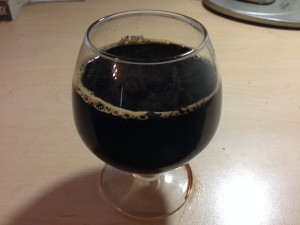This is the eighth article in my series on Russian imperial stouts.
If your wort has been chilled, and your yeast starter is ready, it’s time to get the fermentation started. The first thing you need to do is aerate the wort. Aeration helps build stronger yeast cell walls and allows the yeast to multiply faster. As with any big beer, the yeast have a tough job ahead of them. Be sure to give them all the help they need with regards to aeration. (See also my article, “Aeration Tips.”)
Most of the time, you will want to give the wort one shot of oxygen prior to pitching, as with most beers. For the biggest examples of this style (in the 11–12% ABV range), however, you may want to give the wort a second shot of oxygen just prior to high kräusen.
Adding a small amount of yeast nutrients is a good idea, too. (Use between half and the full amount recommended by the manufacturer.) This would occur near the end of the boil. Although the yeast have no shortage of sugar to consume, it is always possible the wort is lacking in some micronutrient, like zinc. The yeast nutrients will supply that. For the biggest examples of this style (in the 11 to 12% ABV range), you may want to add half of the yeast nutrients in the boil, and add a second dose – boiled in small amount of water for sanitation — just prior to high kräusen. The idea here is to feed the yeast the nutrients they require as they need them. (In mead making and wine making, this approach is called staggered nutrient additions, or SNAs.)
For Russian imperial stouts in the 8–10% ABV range, adding all the yeast nutrients in the boil and aerating with a single shot of oxygen will work just fine. This is doubly true if you pitched an optimal amount of yeast, or nearly so. Aerating twice and staggering the nutrient additions really only helps for the biggest beers, or when you have severely underpitched the wort.
Fermentation Temperature
Ester production is increased by higher wort temperatures, higher wort densities, lower amounts of wort aeration, and lower pitching rates. The effect of these variables can most easily be seen in yeast strains that produce the most esters, such as “fruity” English ale yeasts. Holding the fermentation in the middle to low end of the yeast’s fermentation temperature range should allow you to get the level of esters you want from your yeast strain, presuming you have pitched an adequate amount of yeast and aerated thoroughly.
Fermentations generate their own heat, and high-gravity fermentations generate more heat than low-gravity fermentations. As such, when fermenting your Russian iImperial stout, watch that the temperature does not rapidly rise at any point. This will most often happen around high kräusen – the peak of fermentation activity. Whatever your means of holding the fermentation temperature constant, be ready to redouble your efforts around this time. Conversely, as the fermentation slows, you may need to ensure the temperature does not start to drift too low.
Optional Finishing Techniques
If you raised an adequate amount of yeast, aerated the wort adequately, and held the fermentation temperature somewhat steady within its recommended range, your fermentation should be orderly. In other words it should start in a reasonable amount of time, proceed without getting sluggish or stuck, and finish at a reasonable final gravity (FG). This is doubly true for Russian imperial stouts in the lower half of the OG range.
For the biggest stouts, or beers that for some reason struggled during fermentation, sometimes you need to help them finish. If the fermentation has slowed to a crawl, but is nowhere near your target FG, rouse the yeast and let the fermentation temperature rise.
To rouse the yeast, you can use a sanitized, long-handled brewing spoon to stir the yeast into suspension, or you can swirl the fermenter. Be aware that this will release CO2. If you are not careful, the beer can foam excessively and you may lose some. To prevent this, stir or swirl the fermenter very slowly at first. If foam starts to rise, stop agitating the wort and let the foam recede before resuming stirring or swirling. Do not stir or swirl so vigorously that you aerate the beer.
Once the yeast has been roused, let the temperature rise to the top of the yeast’s fermentation range. Hold it there until fermentation ceases. (If the fermentation still doesn’t finish as planned, see my articles on dealing with stuck fermentations.)
In the next article in the series, I’ll discuss conditioning a big ale such as a Russian imperial stout.
—
Related Articles
Five Tips for Big Beer Fermentations


https://beerandgardeningjournal.com/ris-condition/ <– part IX